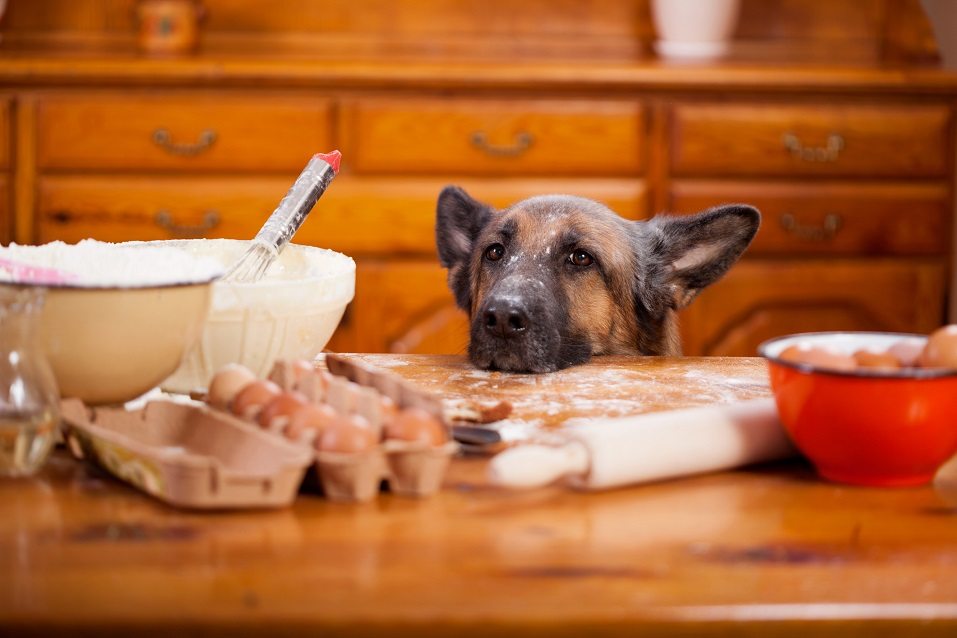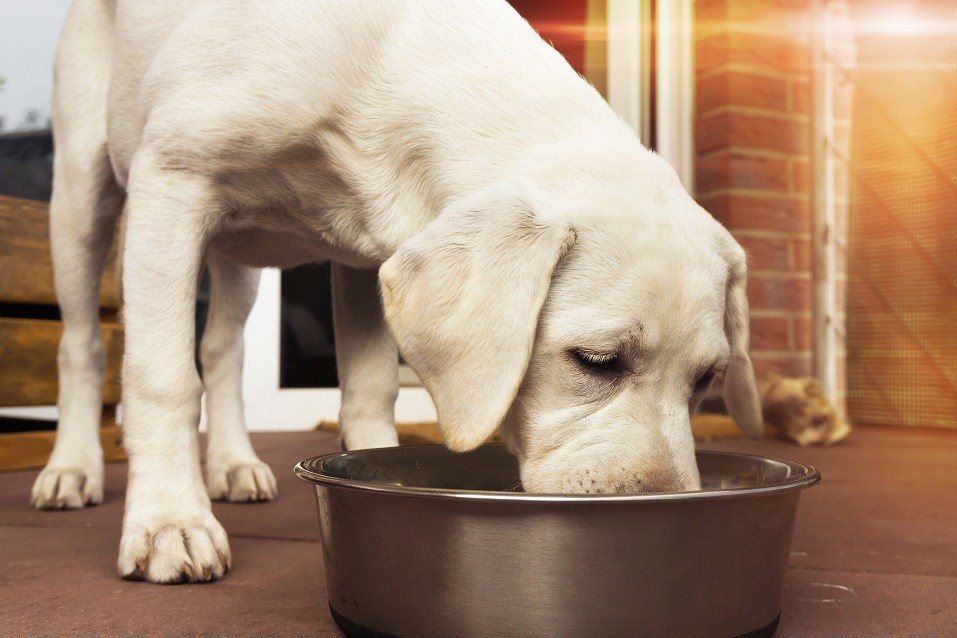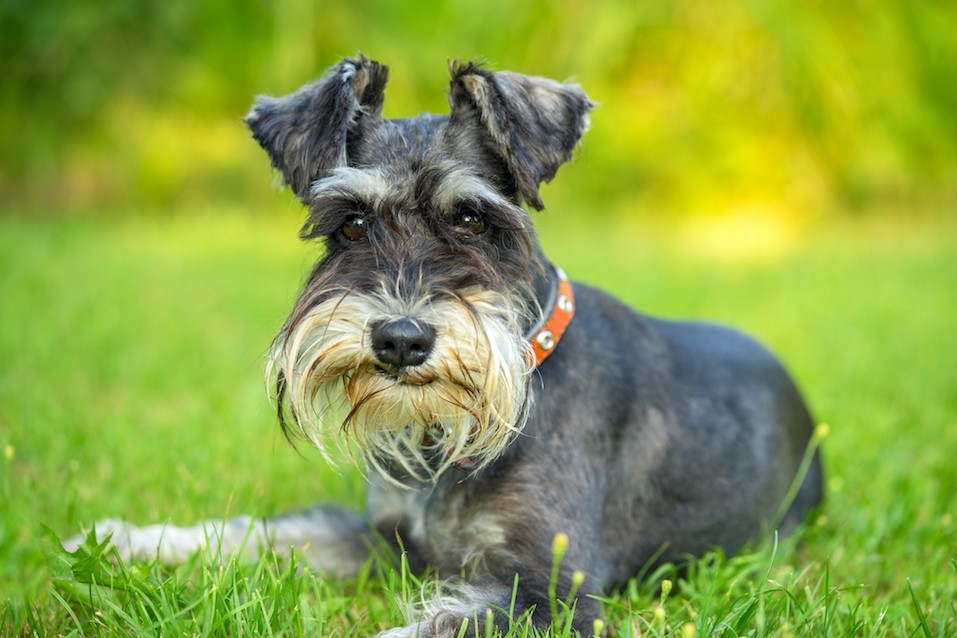Part Two of those breeds!
ooOOoo
11. German shepherd

The German shepherd is another intelligent and active breed. Though German shepherds are large, the AKC reports they have a medium energy level. And the organization characterizes the German shepherd as “a loyal family pet and a good guard dog, the ideal choice for many families.” The AKC notes with a German shepherd (and other breeds), “Training is one of the most important responsibilities you have as a dog owner. Basic obedience training will make your dog a better companion and strengthen the bond between the two of you.”
Poorly trained German shepherds can develop behaviors, such as excessive barking, digging, and food stealing. But this dog breed responds well to training. According to the German Shepherd Dog Club of America, your German shepherd needs “you to be the leader of the pack, providing structure and guidance.” Another way to bond with your dog? Regular grooming. The German shepherd’s thick coat requires weekly grooming.
12. Italian greyhound

Don’t be intimidated by the Italian greyhound’s speed or graceful looks. The AKC reports this breed is “generally easy to train and prefers to spend most of his time with his owner. They like attention and affection, and are a peaceful, gentle friend to adults and children.” If you have large dogs or active children, you’ll need to make sure your Italian greyhound doesn’t get injured by rough play. But for the most part, this dog breed will be happy to run and play — before curling up with you to be a couch potato.
Because of their small size, Italian greyhounds can live happily in an apartment just as well as in settings with more space. The breed generally stays quite healthy. And because these dogs have a short coat, they need only weekly grooming with a soft brush. In fact, the AKC characterizes them as one of the easiest dog breeds to groom. They love to cuddle and don’t want to be ignored. And in general, they’d prefer to chill in your lap or on your bed, rather than on the floor.
13. Labrador retriever

America loves Labs. So it probably doesn’t surprise you to hear these adorable dogs are easy to own. Labs can learn just about anything that you throw at them. The AKC reports Labs are friendly and outgoing. They make great companions, show dogs, hunting dogs, guide dogs, and service dogs. Labs also make great family dogs because they get along easily with children and with other pets. Plus, they have a short coat that requires only occasional grooming.
So it’s no accident the Labrador retriever is the most popular dog in America. They live long and healthy lives. They have playful personalities, and they want to entertain and help you. Plus, they’re good companions for athletic people and can even train as canine athletes themselves.
However, Labrador retrievers qualify as what the AKC calls a “very active” dog breed. So don’t expect them to lounge on the couch all day. “Don’t confuse his laid-back personality for low energy,” the organization warns. “The Labrador retriever is extremely active — he’s never met a backyard he didn’t like.”
14. Maltese

Another people-pleasing dog who will be easy to own and spend time with is the Maltese. According to the AKC, the Maltese is a “classic lapdog” who’s “somewhat active.” These dogs like brisk walks, playtime, and learning new tricks. However, the organization warns that Maltese are “highly intelligent and know very well how to use their charm to get their way. If given the chance, they become easily spoiled. This isn’t a problem for dog-savvy owners, but many pet owners will give in, often resulting in a pet with poor manners.”
Though they’re energetic and playful — which makes them great family dogs — many breeders don’t sell them to homes with young children. As a tiny puppy, a Maltese can be seriously injured if stepped on or dropped by a child. However, the Maltese is known as one of the few small dogs who aren’t susceptible to any major genetic ailments. So if it’s important to you that you choose a dog likely to stay in good health, the Maltese might be a good match for you.
15. Miniature schnauzer

The miniature schnauzer is a fast learner. The AKC characterizes the breed as “friendly,” “obedient,” and “smart” — three characteristics that many pet owners want in a dog. Another desirable trait? According to the AKC, the miniature schnauzer is “highly adaptable.” He can “make himself at home anywhere as long as his people are close by.” This small dog breed has a moderate energy level. And because these dogs crave human companionship, they are “obedient to commands” and can be trained for all kinds of activities.
According to the AKC, this dog breed is “small enough to adapt to apartment life but tireless enough to patrol acres of farmland.” The breed is generally healthy and long-lived. They have outgoing personalities and will stay loyal to their family. Just keep in mind this terrier likes to bark. So proper training will play an essential part in helping him to curb that behavior.
16. Papillon

Unlike many other small dogs, the papillon has a big appetite for exercise and activity. The AKC reports this dog breed has a medium energy level and generally needs to stay “very active.” In fact, these dogs “love to play outdoors but they can be easily entertained and exercised indoors as well.” This dog breed is very intelligent, but the AKC promises these alert and friendly dogs are “easily trained.”
Plus, Animal Planet characterizes the papillon as “one of the most obedient and responsive of the toy breeds.” Though some can be timid, they are often friendly toward strangers and other animals. And the papillon also makes a good family dog because the breed likes children. They have a medium-length coat without an undercoat, though they still require regular brushing.
17. Poodle

Many people know the poodle is a highly intelligent dog breed. And even though intelligence doesn’t always ensure a dog responds well to training, the AKC promises that the poodle “excels in obedience training.” Although some poodles can be stubborn, proper training mitigates that trait.
The AKC notes, “There’s the old stereotype of poodles as a foofy velvet-pillow dogs looking down their long noses at us. Not true. Poodles are eager-to-please, highly trainable ‘real dogs.’ They like to work closely with their humans and can master all kinds of tricks and dog sports.”
Modern Dog Magazine reports of the standard, miniature, and toy poodle, “All poodles are lively, fun-loving, affectionate, and intelligent, and many owners say the breed has a sense of humor to rival Seinfeld’s.” The miniature poodle can be shy around strangers. But the standard is outgoing. They have a medium energy level and enjoy walking, running, and swimming. Just be aware this dog breed’s long coat, while somewhat hypoallergenic, does require regular professional grooming.
18. Pug

Like the bulldog, the pug has a grumpy face that might make you think he’s not so friendly. But don’t let looks deceive you. The AKC characterizes the pug as “even-tempered, charming, mischievous and loving.” These dogs aren’t natural athletes, but the AKC advises that “they do have strong legs and endless curiosity — exercise both.” These extroverted dogs love children and adults alike. And according to the AKC, “Pug people say their breed is the perfect house dog. Pugs are happy living in the city or country, with kids or grandparents, and as the family’s only pet or among other animals.”
This dog breed has no problem making friends with complete strangers. PetWave calls this dog breed a “shadow” because pugs “love to glue themselves to their owners’ sides and stay close to the action.”
And though some people think they’re more difficult to train than other dog breeds, that’s largely because they’re easily distracted. The pug sheds but needs minimal grooming. And you will need to monitor your dog’s diet to keep him healthy because, according to the AKC, “pugs live to eat.”
19. Rottweiler

The AKC also recommends the Rottweiler as one of the smartest dog breeds. This medium-sized dog also has a medium energy level, according to the AKC. But let’s just get this out of the way: A Rottweiler won’t be one of the easiest dog breeds for you if you can’t give him two solid workouts each day. But their need for daily exercise is at least somewhat offset by their minimal grooming needs.
PetWave reports though this breed has gained something of a reputation as an attack dog, “this is not their true nature.” The publication explains that for Rottweilers “to be vicious, they must be trained that way.”
Often, dogs who spend their days isolated from people are the ones who develop unpleasant traits. The AKC explains, “Obedience training and socialization are musts” for this dog breed. “Rottweilers love their people and may behave in a clownish manner toward family and friends, but they are also protective of their territory and do not welcome strangers until properly introduced.”
20. Shetland sheepdog

The Shetland sheepdog also has a reputation for intelligence. But that won’t work against you with a Sheltie, as it can in other dog breeds. According to the AKC, this dog loves “learning new tricks. Shelties are easy to train and are world-class competitors in obedience, agility, and herding trials.” And the AKC advises, “The Sheltie will reach his best potential [as] a companion when given training in basic manners at the very minimum.”
PetWave characterizes the Shetland sheepdog as “an all-around family dog.” They like indoor and outdoor activities. And they get along well with children, as well as with other pets. These small dogs can live in an apartment if they get daily walks and regular opportunities to run. Shelties have a dense double coat and need weekly grooming.
21. Mutt

Not everybody wants to buy a purebred dog from a breeder or search for one at the local shelter. And you don’t have to pick a purebred dog, even if you’re a novice dog owner just hoping for a pup who will be easy to train and care for. The AKC, of course, notes you can better predict a dog’s traits if you know his lineage. But you can often make an educated guess at which breeds are in a mutt’s genetics. And there are some very good reasons to choose a mixed-breed dog instead of a purebred.
For one, the incidence of many genetic disorders is higher in purebred dogs than in mixed-breed dogs. Plus, by staying open to adopting a mixed-breed dog instead of a pedigreed dog, you’ll be able to adopt a shelter dog who needs a home, not just a puppy who was specifically bred to be sold for top dollar. Additionally, purebred and mixed-breed dogs show no significant differences in terms of their trainability. So a mutt is just as likely to learn to be obedient and attentive as a pedigreed dog.
ooOOoo
What better way than to close this short series with a Mutt!
And welcome to the Winter Solstice!
Great post Paul 🙂
I will add, that both the German Shepherd and the Rottweiler are not for beginners. We need to be very awake to them to raise them in the right way. No one of them are great to have, if not well raised. Then they end up at a shelter, just because of the owners not experience with them, which is sad for the dogs.
They are not the best to stay alone at home every day, while the owners are working and only get contact early morning and late evening. This will frustrate them.
LikeLike
I agree regarding the Rottweiler and German Shepherd. But then again that applies to so many breeds that are not cared for.
LikeLiked by 1 person
You are right Paul, I just see these as difficult for beginners, because we need to be mentally very strong to have these kind of dogs. They demand a lot of us, but are also very loving dogs in the right hands. As you might know, Odin is a mix of German Shepherd, some Labrador and some Rottweiler. His behavior is a mix of German Shephard and Rottweiler, so I do know, how difficult, as they can be too. A challenge, but worth the challenge 🙂
LikeLike
Beautifully put, Irene!
LikeLiked by 1 person
Thank you, Paul.
LikeLike
I also like quite a few breeds on this list. Pugs. I always wanted one. I would have to name him Frank for Men in Black. 😉 Glad to see Rotty’s made the cut. They may look formidable but they are sweethearts. Wonderful work. I hope you & Jean have a great holiday.
LikeLike
Thanks Susan. We tend to celebrate the Solstice as the turning point in the winter. But the same to you; whatever the day!
LikeLike
Personally, I like Cockapoos. They seem to take the right mix of traits from Cockerspaniels and Poodles. They do need good training though…exuberant, energetic and loving.
But seriously, I have seen some gorgeous mutts. Purebreds have more genetic problems so a mix of the gene pool puts the dogs back on a healthy track.
What ever dog anyone picks, it will generally look and act much like its person…have you ever noticed how people pick pets that reflect their own nature. Sometimes it can be quite amusing to see. 😆
LikeLike
Yes, many times! Of our six dogs here only one, Cleo, is not a mutt!
LikeLiked by 1 person
I note with wry amusement that neither side of my Ani’s dual parentage… Setter/Toller is mentioned anywhere in these lists 😉 However, as the previous comment mentions… her joyful lunacy may be as much down to me as genetics.
LikeLiked by 1 person
Love it!
LikeLike
🙂
LikeLike
Italian greyhounds are great😍
LikeLike
Welcome! Hope to see your again.
LikeLiked by 1 person
I always like a mutt. Healthy and smart. All different.
LikeLike
Yes, we agree with you!
LikeLiked by 1 person
Thanks for another informative post Paul!
LikeLike
My pleasure!
LikeLike
Mutts Rule!
Just barking…😉
Nose nudges,
CEO Olivia
LikeLike
🙂
LikeLike
Great post! This was really helpful, thanks Paul 🙂
LikeLike
Cayenne, thank you!
LikeLiked by 1 person
I am considering a small dog, even though my better half is coming up with all the excuses as to why not.. I keep saying all the positives.. I keep chipping away Paul and January is looming fast.. 🙂
LikeLike
Sue, only just noticed your reply to this post. That’s because on December 22nd I was on the verge of having to go back into hospital and blogging rather took a background position! Can’t recall but did you get that dog?
LikeLiked by 1 person
Dear Paul please no need to apologise my friend I did not expect it as you had so much to contend with your hospital interlude.
As to the Dog.. Sadly no.. I may drop you a line in explanation.
LikeLike
Sue, yes please do drop me a note!
LikeLiked by 1 person
A note has been sent Paul
LikeLike
And received!
LikeLiked by 1 person
Do it. Do it. Do it….since getting my Labrador, it’s been brilliant fun, so much so he got me into blogging.
LikeLike
Thank you Stareofthedog, 🙂 for that encouragement.:-) Big Smiles. and a big thank you
LikeLiked by 1 person
Love this post and the previous one Paul. 💛
LikeLike
Thanks Val. Better late than never!!
LikeLiked by 1 person
Wonderful list! My children and I really enjoyed the photos=). I have to say as an adult dog owner who grew up with a poodle when I was very young as my first dog, I was spoiled and had no idea. That dog was so smart and obedient. We now have a very smart terrier mutt, but the way our poodle stayed in our yard if told to sit and stay and ran figure 8s just within those boundaries was a one of a kind experience for me. Happy Holidays!! ~Anne
LikeLike
Thank you Anne for your kind words and wishes! Sure you understand why I am late in saying so!
LikeLike
A terrier mutt eh. I have a Choc Lab who I blog about but, do quite fancy a terrier mutt as well. Is it good with families? I know Labs are which is why I got one.
LikeLike
I was more the messenger in the sense of republishing that article. Maybe try going across to the Cleatsheet site that I linked to in the first part of the article.
LikeLiked by 1 person
Ahah. i see
LikeLike
He is great with everyone but a little ornery with our 3 1/2 year old at times😉. Smart and energetic….probably a Norfolk/Jack Russell mix. Your dog is adorable. Labs really are amazing😊!!
LikeLiked by 1 person
Ah thanks for that compliment and that information. Best wishes.
LikeLike
Always been a big dog man myself. Currently have a choc Labrador I bkog about regularly. From the list above though, I had Alsations ( German Sheps) as a kid. Great family dogs, though the ones we had were difficult to truly trust with anyone beyond the immediate family.
LikeLike
Just been across to your place and like it!! Thanks for calling by and hope to see you again!
LikeLiked by 1 person